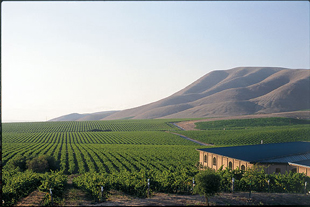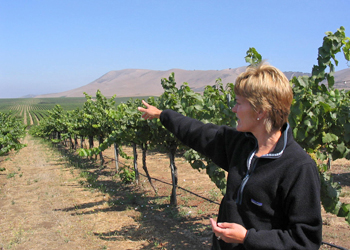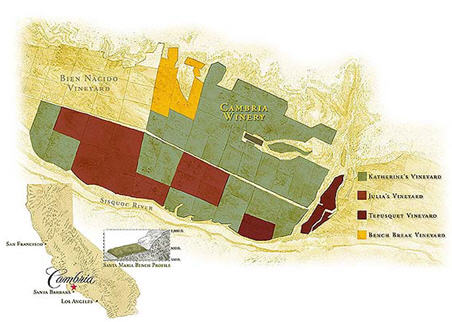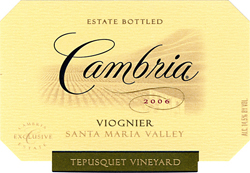

Cambria's winery building is surrounded by its vast vineyards that seem to stretch to the horizon, past the prominent Santa Maria Bench on the right.
Cambria Winery – It All Comes
Back to Terroir
by
Michael Lasky and Dennis Schaefer
December 3, 2007
 f anything is demonstrated clearly at Cambria Winery & Vineyard, it’s their devotion to faithfully transferring their vineyards into the glass. And with 1,400+ acres of estate vineyards well-rooted in the interior heart of Santa Barbara county’s Santa Maria Valley, that’s not exactly the easiest of tasks.
f anything is demonstrated clearly at Cambria Winery & Vineyard, it’s their devotion to faithfully transferring their vineyards into the glass. And with 1,400+ acres of estate vineyards well-rooted in the interior heart of Santa Barbara county’s Santa Maria Valley, that’s not exactly the easiest of tasks.
The winery, best known for its Katherine’s Vineyard Chardonnay and Julia’s Vineyard Pinot Noir, is owned by the (Jess) Jackson family who purchased it in 1987, back when it was known as Tepusquet Vineyard. Jackson renamed the winery Cambria , which is the Roman word for Wales, in honor of his family heritage. (Catherine and Julia are named for the Jackson’s two daughters.)
Under Jackson’s care, the estate has grown, as has its reputation for affordable, totally estate grown, produced and bottled wines. Because of the sheer size of the estate, the vineyards are affected by various terroirs on the property.
And terroir was first on the agenda when I met up with Cambria’s winemaker Denise Shurtleff. She immediately led me out of the winery building, up to a nearby bluff that overlooks Katherine’s Vineyard and

Denise Shurtleff points over Katherine’s Vineyard in the direction of the Pacific Ocean 17 miles due west, a major influence for all of Cambria’s vineyards.
“Even though our vineyard is approximately 17 miles inland, we are still subjected to the strong cool winds that come off of the ocean, due to the east/west direction that the valley runs and the way that it opens directly into the ocean. Our climate is very cooling which makes for a long growing season. Our warmest temperature of the day generally occurs around noon, then it starts cooling off because of the winds. This allows for a mild year-round climate and results in one of the longest growing seasons in the state. The long growing season makes for great varietal character development in the grapes, balanced acid content, and rich textures in the wine.”
Shurtleff points out that Santa Maria Valley has one key difference from other California valleys. “Most of the other valleys in California (Napa, Sonoma, Mendocino, etc) are north/south running valleys with a mountain range between the ocean and the valley. These areas do not experience the maritime influences until late in the afternoon or evening, therefore, the grapes and vines are subjected to longer periods of high temperatures and the growing season is shorter,” she explains.
Shurtleff came to Cambria Winery in 1999 after a sixteen year stint as winemaker and Winery Manager at Corbett Canyon Winery. Although she adamantly believes that wines are made on the vines, her meticulously blending from the estate’s multiple vineyards, using a panoply of different wood barrels might suggest that wines are made in - get this - the winery. But, Shurtleff insists that happens only after varietal characteristics are solidly developed before the fruit is harvested.

The vineyard map of Cambria shows some of the varying terroir on its estate. (The Pacific Ocean is on the left only 17 miles away.)
The estate spans multiple terroir extremes, offering a varietal and clonal palette that Shurtleff uses to wow our palates. And despite the high case load of Pinot, she has, year in and year out, made the wine as if it were hand-crafted.
So just what are the defining characteristics of the estate’s benchmark grapes? Shurtleff says Chardonnay typically has “bright citrus characters - citrus blossom, ripe tangerine and pink grapefruit - along with tropical fruit characters (ripe pineapple, guava), stonefruit such as white peaches and apricots, and crisp apple flavors.”
So how does she maintain the consistency of the Cambria Chardonnay from vintage to vintage? After all, consumers expect a certain flavor and mouth feel from Katherine’s Vineyard Chard. How does she keep all those wonderful variables and yet achieve a recognizable taste?
“The Chardonnay grapes have proven to be more consistent year to year in aroma and flavor. That makes my job much easier. The Pinot, on the other hand, is more temperamental, more subject to climatic influences.
For Cambria’s Pinot Noir characteristics, she notes “cherry, strawberry, pomegranate and blueberry fruit characters with balanced tannins and silky textures on the palate.”
Syrah - also grown in Cambria’s Tepesquet Vineyard - brings out “cherry cola, blackberry, white pepper, cinnamon and nutmeg spice.”
She adds: “Due to the acid content of the grapes, our Chardonnays and red wines all undergo complete malolactic fermentation, resulting in wines with rounded mouth feels but with crisp, balanced finishes.”
 The property also grows a comparatively small amount of Viognier - enough to bottle about 500 cases. Shurtleff admits “Viognier is my fun wine. It is the easiest to pick. It all comes together at the same time and there is no second guessing. Also, its high phenolics help the aging.” That explains why Cambria’s Viognier holds up in the bottle for years. Along with the Syrah, her Viognier ‘kids’ are grown in Cambria’s Tepusquet Vineyard. Located at the eastern-most portion, it sits on a downward slope, which naturally shelters the vines from Santa Maria’s typically strong winds. Its sandy, porous soil, once a prehistoric river bed, is particularly well-draining.
The property also grows a comparatively small amount of Viognier - enough to bottle about 500 cases. Shurtleff admits “Viognier is my fun wine. It is the easiest to pick. It all comes together at the same time and there is no second guessing. Also, its high phenolics help the aging.” That explains why Cambria’s Viognier holds up in the bottle for years. Along with the Syrah, her Viognier ‘kids’ are grown in Cambria’s Tepusquet Vineyard. Located at the eastern-most portion, it sits on a downward slope, which naturally shelters the vines from Santa Maria’s typically strong winds. Its sandy, porous soil, once a prehistoric river bed, is particularly well-draining.
Blending – The Sum Doesn’t Necessarily Equal the Parts
The art and science of blending wine, especially on an estate as large as Cambria’s, is not for the fainthearted. Denise Shurtleff finds the challenge is the most exciting part of her job. Just what’s involved?“The blending process involves combining grapes from multiple vineyards, from single vineyards, and from individual blocks from particular vineyards. In blending Pinot, for example, I have to blend, through repeated trials, different clones from different parts of the vineyard but sometimes from the same part of the vineyard.
“Then I must select the appropriate barrel wood that I think brings out the best in each clonal selection. Other factors in blending include the right amount of aging time










 READER FEEDBACK: To post your comments on this story,
READER FEEDBACK: To post your comments on this story,



